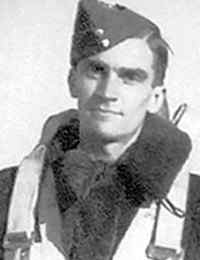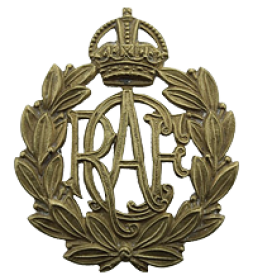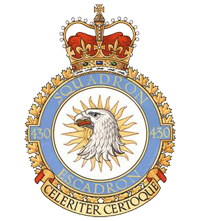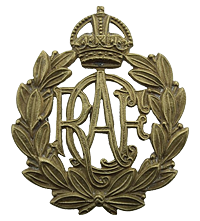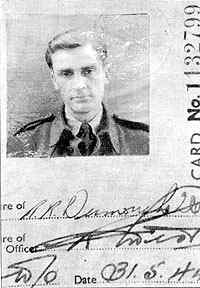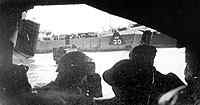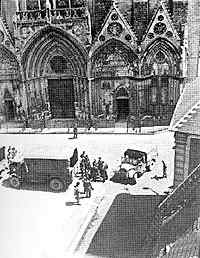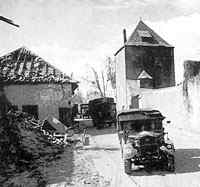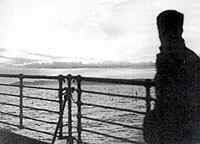My story begins in England. The 2nd Tactical Airforce was composed of many squadrons. I 'wasn't told beforehand the purpose of this temporary duty. There was one aircraft, one pilot and one ground crew member picked from each squadron and all lined up outside London on an air field. I figure I was picked because I always kept myself looking smart 1 always dressed properly and shaved every day. A lot of the guys got away with looking pretty scruffy, but I was proud of the uniform. Anyway, the King walked through it all and spoke to the pilot next to me. I could hear his hesitation, his stutter. I realize now after more than fifty years what an honour it was to have been picked amongst all the ground crew from the squadron to represent the R.C.A.E at this inspection.
May 11/44...left Odiham arrived in Hurn
Now we moved south in convoy as a squadron. At the time we didn't know why. The invasion was very hush-hush.
May 12/44...left hurn arrived Salisbury
Southern England at the time looked like solid airfields, all for the defense of the country. They were filled with fighter aircraft, which, because they carried less fuel, stayed south to intercept raiders coming in.
May 27/44...left Salisbury returned to Hurn
We were beginning to load our trucks with spare aircraft parts and equipment. I tried to sneak my bike in after all, it had cost me a quid but got caught, and was told, "You're not going to need that where you're going." So then we knew: INVASION ! ! !
June 5/44...informed the invasion to begin
Our section officer who told us said that it was not yet common knowledge. We went to breakfast the next day and nobody else knew. I guess our officer jumped the gun because he trusted us.
June 6/44...Invasion begins. We left Hurn, arrived in Old Sarun
The Catholics were given general confession on a tremendous field. Every ally, every nationality was gathered there - Canadians, Poles, free French, Russians, whatever - a sea of people. Far away there was a platform with ;m Irish priest on it, giving us general confession and absolution in the thickest of brogues over a sound system.You felt that right there you were really absolved of your sins; that you had sincere contrition.This massive sacrament was only given to men going into battle.
June 14/44...boarded invasion craft for France
I don't remember being afraid. I'm sure there must have been fear, but have found that kind of memory doesn't stay with you. But I do remember thinking: Hey! There must be a mistake here! I'm in the air force! What am I and a few R.C.A.F. ground crew doing on an invasion craft with a bunch of British commandos, storming the Normandy beachhead with my trusty 303 rifle? I left the Essex Scottish for the Air Force so I wouldn't have to do this kind of thing! What happened to the wild blue yonder? Matson was still with me. We exchanged letters -he wrote a letter to his wife and I wrote one to my family. If one of LIS didn't make it. the other would mail the letter given to him. That was on D-Day +8. From a book I recently read about the invasion,! found out about Kirk Maier, a German accused of killing so many Canadians in cold blood instead of taking prisoners. I've realized how close we came to being a second Dieppe. We had arrived only three miles behind the front line. The German generals could have cleaned that beach off so easily, pushing us right back into the Channel, had Hitler allowed them to follow their plans. But he thought the landings were a diversionary tactic and that the real invasion would take place else-where.Thus. The German leaders had to sit on their hands, allowing us all to gain a foothold. We sat in the landing craft for two days. I don't know why they didn't let us land - maybe there was too much congestion.
June 16/44...landed on the beach near Asnelles
We got bombed the night we landed. I crawled under an ambulance and slept a bit. To drive our truck, which was loaded with spare plane parts and personnel - us - off the landing craft, they picked a ground crew member from our mobile photo processing truck who wore thick Coke-bottle-bottom glasses. I don't know how he ever got in the Air Force. He drove down onto the beach and tipped the truck over into a ditch. Everything landed on top of me, cracking two of my ribs.When the truck got righted we started driving down a road for some distance but got stopped by the Army, one of whom called out."Where the bloody hell do you think you're going? Jerry's just over the next hill!" We backed up.
June 16/44...arrived 124 A.F. at St. Croix, three miles behind the front line
I stumbled around in great pain until I found the M.O. trying to put up a tent. He said, "I can do two things: I can tape it up - it's gonna hurt like hell. Or I can leave it the way it is - it's gonna hurt like hell." I said/Leave it the way it is."
June 17/44...arrived 127 A.F. Bazenville
In that first two weeks, the engineers picked a farmer's field to clear a strip on the ground with bulldozers. Then they laid down heavy steel mesh to serve as a run-way. Mustangs and Spitfires would fly in from England on photo reconnaiscence. Each would take a whole camera magazine of shots, then land at our airfield to have us remove tlie exposed magazine. We'd hand it to the pilot in exchange for an unexposed mag that was stashed in the cockpit. It would get reloaded, and up the plane would go for another sortie before returning to England.The Mustangs were too precious to leave in France, but they left us there. The Canadian Army's tanks were rolled down into big angled pits dug by the engineers.This tilted them upwards so their long range guns would get more elevation to fire into encmv positions. So, initially at this airfield there w^ere a handful of us photo bashers and some armament people to service the planes' guns. Of course, there was army all around.
June 30/44...arrived 128 A.F. Sommervieux, Bayeux
About two weeks after we landed, another photo crew was flown in. Included were two friends from Windsor, Mike Bunt and John Coulter. Mike said, "What are you guys doing here?" H.Q.had expected much of our group to be casualties, and they were our replacements. Others had come to operate the mobile processing unit when it arrived. By this time I'd been promoted to corporal and was paid corporal's wages, but didn't have to wear the stripes. Eventually though, Matson was promoted to sergeant, and I took over as head of the camera section. My stripes went on my sleeves then. The city of Bayeux was only walking distance away. In its cathedral hung a famous tapestry. To attend Mass we stood on the balcony, rifles over our shoulders, watching the balconies all around the top fill with commonfolk who stood too. Onto the main floor would march the mayor, councilmen and dignitaries to their own special seats. Then Mass would begin.
After France, Belgium, Holland and Germany I got to go back home. We boarded the S.S. Samaria in Liverpool and it took us back to Quebec, Canada where we arrived on 27th August 1945. I got back to my home town of Windsor on 29th August 1945.
Robert R. Dumouchelle
